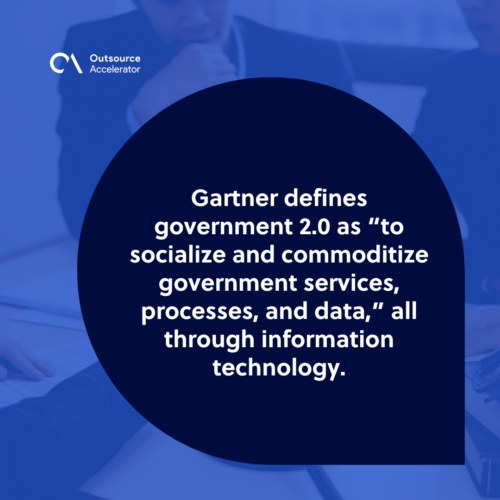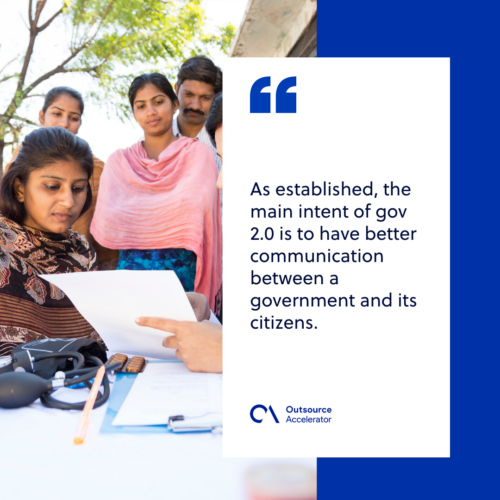Government 2.0: The modernity of governance

It wasn’t long ago when politicians had to make public speeches to connect with their community. They would stand outside a government building or in a local plaza and speak behind a podium.
Common folk would come and watch. Some others listen through their radios or watch on TV. A few would wait a day or two to read about the speech in the newspaper.
From this, it may be concluded that communication between the government and its citizens used to be overwhelmingly one-sided. But with the rise of government 2.0, this is no longer the case.
Gov 2.0 is the epitome of modern governance. It uses advanced technology and social media for instant communication.
With gov 2.0, citizens can conveniently participate in political conversations. Additionally, government representatives have easy access to their citizens’ thoughts, including opinions on where their administration is lacking.
Read this article to find out more about government 2.0, its characteristics, and the challenges that come with it.
What is government 2.0?
Gartner defines government 2.0 as “to socialize and commoditize government services, processes, and data,” all through information technology.
In simpler terms, Government 2.0 is the use of technology to establish a more transparent form of governance.

The main intent behind this is to enhance the levels of connectivity and communication between citizens and their government.
In gov 2.0, the masses play a more significant role in forming policy and government information is made more accessible to the public eye.
Many governments internationally have adapted to this concept. They do this in an effort to provide better service to their respective citizens.
Let’s delve deeper into gov 2.0 by enumerating some of its characteristics and challenges it poses.
Characteristics of government 2.0
What makes Gov 2.0 the way it is? Aside from the use of technology, the following characteristics diffirintiates government 2.0 from the traditional form of government:
Citizen-driven
It requires an outside-in approach. Citizens process and transform government information, modify the services they want to use, and integrate them with information and services outside the scope of government.
Transformative
It’s about changing the government status quo in various ways, including innovation, transparency, collaboration among members, and citizen participation. These add up to a significant transformation of government.
Demands a new management style
Gov 2.0 requires managers to let their employees experiment with social media and external engagement. As a result, it’s necessary to measure employee performances.
This shall be conducted based on their contributions to the policy outcomes for which their agency is responsible.
Employee centric
Further, gov 2.0 requires employees to collaborate with each other. They are to challenge existing procedures by being innovative while still remaining accountable. This makes gov 2.0 employee-centric.
Constantly evolving
The transient nature of social networks demands a repetitive process where employees are constantly looking for what matters to them and their jobs. Social networks will revolve around specific issues and may come and go as constituents see fit.
Government 2.0 challenges
Government 2.0 is a somewhat bizarre idea and poses some challenges.
Since it encourages citizens’ input, there needs to be moderation. A filter is needed to sort between citizens who have valuable contributions and those who only wish to ensue chaos.
Additionally, with Government 2.0, there needs to be an establishment of leadership. Gov 2.0 requires not only one leader but rather collective leadership. A group of qualified individuals must complement each other and fulfill a set of leadership roles.
Gov 2.0 also requires the attention of citizens. As established, the main intent of gov 2.0 is to have better communication between a government and its citizens. There’s almost no point if the target market does not regularly utilize it.
On top of that, government 2.0 calls for the development of mutual trust. Not all citizens will believe everything a government agency or representative says online. A few will also demand even more information if they feel they’re not getting the full picture of a topic.

The future of government 2.0
Technology can only get better and more complex from this point forward, and so will gov 2.0.
Learning to adapt to new technologies is a concept that governments around the world should get used to. Using them as an advantage is even better.
However, one aspect of government 2.0 shouldn’t be subject to change: the main goal of being transparent to common folk and connecting with them.
Non-government employees comprise the majority of a community, making their input the most significant. Public servants listening to their people can cultivate peace and order in their community.







 Independent
Independent




